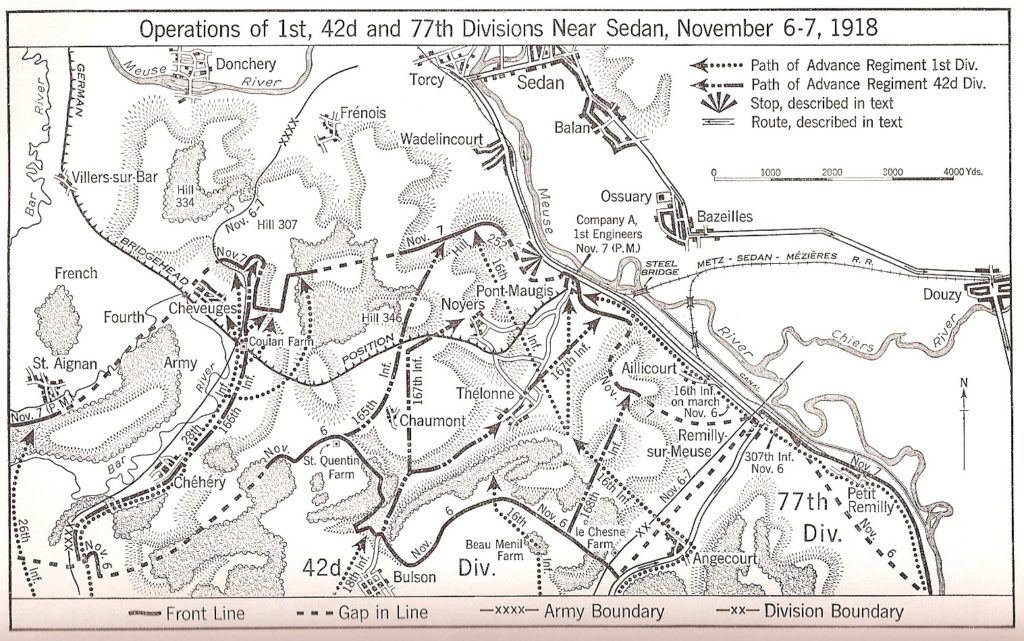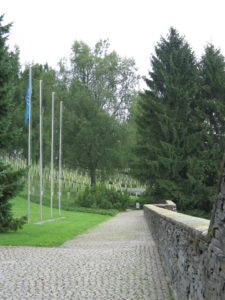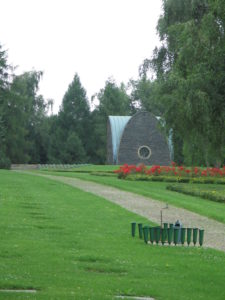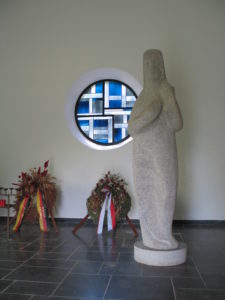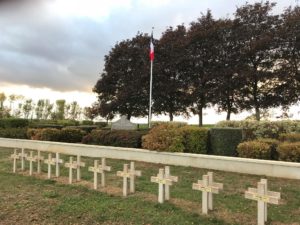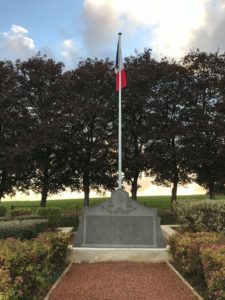Few American battlefield visitors drive as far north as Sedan, because it is approximately one hour (55km / 35 mi) north of Romagne-sous-Montfaucon. However, for those with the time, it is worth the drive because Sedan and vicinity is steeped in military history. On 2 Sept. 1870 Prussian troops captured Emperor Napoleon III and a large number of his troops there during the Franco-Prussian War. (Thereafter, Imperial Germany celebrated Sedan Day annually as a major holiday.) In August 1914, the Imperial German troops of the German 4th Army advanced through the region. In November 1918 A.E.F. troops of the 1st Division crossed the boundaries of the 77th and 42nd Divisions in their “Race to Sedan” before Hunter Liggett put a stop to it and allowed the French to re-take the historic city. In 1940, Sedan and neighboring towns (including Stonne) was the site of significant armor fighting during the six weeks or so that the French held off the Hitler’s assault. Thus, Sedan and the surrounding countryside played a key role in the last three major wars between France and Germany.
One great place to visualize all the events is the German and French cemeteries on the heights just west of Noyers-Pont-Maugis and just a few kilometers south of Sedan. The heights offer a wonderful view of Sedan and the area in between. The map below shows the location:
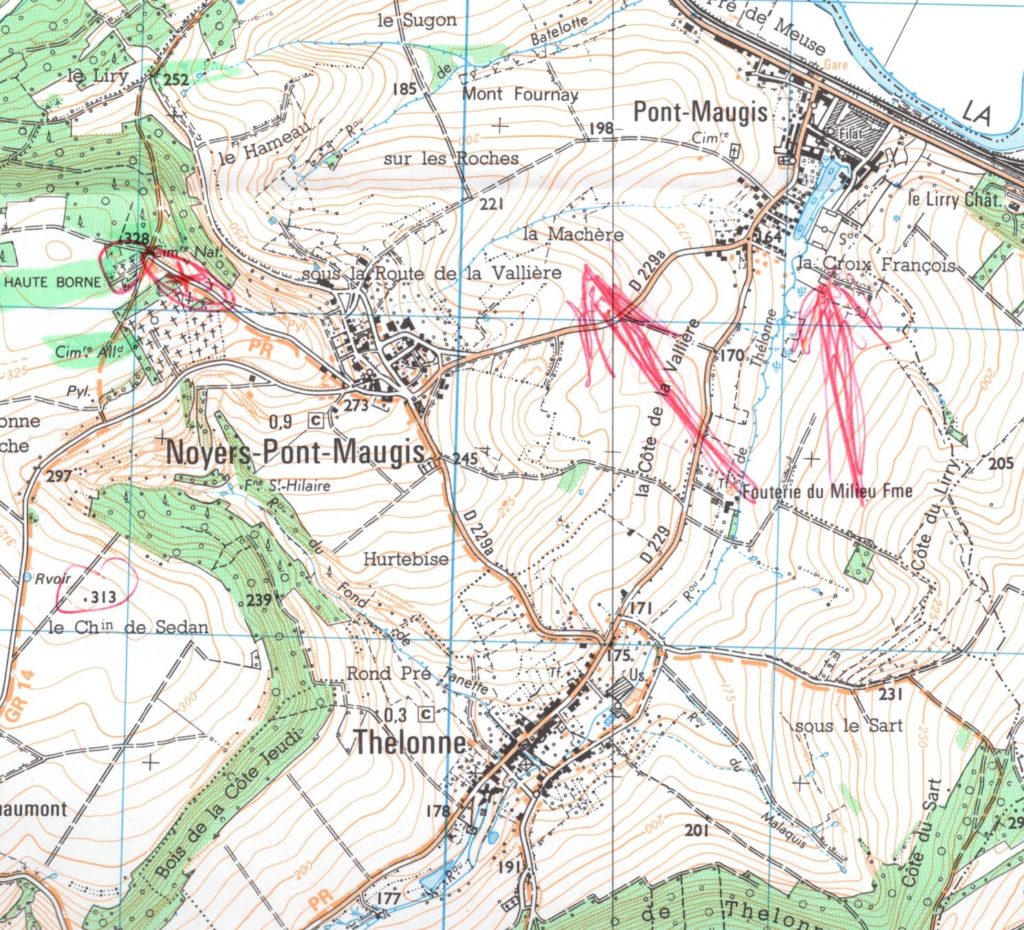
Today’s map showing the German and French cemeteries on the heights just west of Noyers-Pont-Maugis.
Drivers can follow the signs from the village of Noyers to the German cemetery’s main entrance on the south side of the cemetery. From there, they can walk uphill through the cemetery to the north wall. Alternatively, they can take the north fork of the road and drive to the north wall of the German cemetery and the entrance to the French cemetery. (This is recommended if walking distances is a problem.) The Webmaster first visited the site in 2005. Upon returning in 2017 he found a recently-built viewing platform with increased signage just outside the two cemeteries.
Regardless of which period of history they are interested in, readers are strongly encouraged to educate themselves before visiting the area! The story of the A.E.F. in early November will be summarized in this article; but each story outlined in the first paragraph is worthy of an article.
General Pershing’s desire to have the American First Army liberate Sedan, and the way in which his G-3, Fox Conner, and senior First Army officers communicated the desire without informing First Army C.O. Hunter Liggett is a fascinating piece of late-war A.E.F. and coalition war-making history! While a summary will be provided here, readers are strongly encouraged to find a scholarly summary in a books such as “The War to End all Wars: The American Military Experience in World War 1” by Edward M. Coffman. Essentially, after Fox Connor’s visit with First Army Generals Drum and Marshall on 5 November, 1918 the message that was communicated to the Commanders of I Corps (Dickman) and V Corps (Summerall) read as follows:
- General Pershing desires that the honor of entering Sedan should fall to the First American Army. He has every confidence that the troops of the I Corps, assisted on their right by the V Corps, will enable him to realize this desire.
- In transmitting the foregoing message, your attention is invited to the favorable opportunity now existing for pressing our advance throughout the night. Boundaries will not be considered binding.
The 1st Division, part of V Corps, was several kilometers to the east of Sedan and the 42nd and 77th divisions. Nevertheless, focusing on the last sentence of the message and knowing his and General Pershing’s love of the 1st Division, General Summerall issued orders in the afternoon of 6 November for the 1st Division (Parker) to move immediately towards Sedan; but there was no communication of this move to either of Dickman’s two divisions–the 77th (on the right) and the 42nd (on the left.) To make a long story short, by daybreak of 7 November, 1st Division units had crossed divisional boundaries and were becoming entangled with 42nd Division troops, who were in the process of preparing their advance on the city. Furthermore, the French on the left of I Corps became aware of the First Army’s intentions to take Sedan and began to complain, arguing that they should have the privilege of liberating the city. Liggett found out about 1st Division’s activities and the French complaints on the morning of 7 November and he blew his top! His anger was compounded by the fact that neither Drum nor Marshall, two very senior First Army officers, had mentioned Fox Conner’s visit and the resulting message sent to the Corps commanders. (Both had served under General Pershing when he was First Army C.O.) Fortunately, the crossing of divisional boundaries did not result in any disasters and the war was almost over. Nevertheless, as Coffman states: “What happened on the road to Sedan was that personal feelings and relationships took precedence over professional training and common sense.” (Page 353.) The map below outlines the routes of advance taken by various units, notably the 16th Inf. Regt., 1st Division.
Readers should also plan on spending some time at the two cemeteries. The French cemetery is the smaller of the two cemeteries on the hill. It was constructed in 1920 to consolidate the graves of more than 1,700 French soldiers who died during WW1 and who were buried in the surrounding area. It also contains the graves of eight Commonwealth soldiers from WW1 and four Commonwealth airmen from WW2. Unfortunately, the Webmaster could not find any photos of the cemetery in his collection.
The German cemetery is one of the largest German cemeteries in France; containing over 28,000 graves from both world wars, including 14,055 soldiers from WW1 and 12,788 soldiers from WW2. Its construction began in 1922 by French authorities, and a high percentage of the WW1 soldiers buried there fell in in the region during the first and last months of the war. The reason being that the front line stabilized significantly further south of Sedan by late 1914 and remained distant until the last days of the Meuse-Argonne Offensive. The WW1 fallen are buried in Blocks A and B and in a communal grave at the cemetery. Expansion began in 1940, when the Wehrmacht’s Grave Service began to bury its dead in the field next to the original cemetery. This expansion continued post-war. The WW2 fallen are buried in Blocks 1 – 8. Because of its size, the cemetery has a chapel. As of some years ago, it also housed Volksbund offices and it was one of a handful of German cemeteries to have a German Volksbund representative present. (The Webmaster does not know if this is still the case.)
Time permitting, the visitor will be glad that he/she stopped and visited these two cemeteries, exploring decades of history that occurred in the immediate vicinity. Readers are advised to leave time for Sedan and for the various 1940 battle monuments in the region too!
Postscript
After publishing this blog post Eric Mueller sent the Webmaster some photos of the French cemetery and added a few comments regarding the Citadel in Sedan and the village of Stonne: “I was at both last year. Very nice. The French cemetery gives you an excellent view into the Meuse River Valley, and across to Sedan… There’s a nice hotel and restaurant in the Citadel. If you’re in the area also check out Stonne. A nice little village with a big history during the 1940 German drive across France. A Char C2 tank, an anti-tank gun, and a memorial chapel. You can also follow a self-guided driving tour of the battle between French and German armored forces.”
